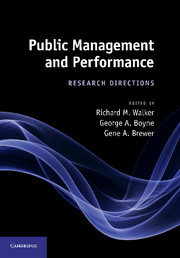Book contents
- Frontmatter
- Contents
- List of figures
- List of tables
- Notes on contributors
- 1 Introduction
- 2 Extending goal ambiguity research in government: from organizational goal ambiguity to programme goal ambiguity
- 3 Budgets and financial management
- 4 Organizational structure and public service performance
- 5 Red tape: the bane of public organizations?
- 6 Managerial networking, managing the environment, and programme performance: a summary of findings and an agenda
- 7 Public service motivation and performance
- 8 Organizational diversity and public service performance
- 9 Performance management: does it work?
- 10 Strategy: which strategic stances matter?
- 11 Methods
- 12 Conclusion: enriching the field
- Index
- References
7 - Public service motivation and performance
Published online by Cambridge University Press: 05 July 2014
- Frontmatter
- Contents
- List of figures
- List of tables
- Notes on contributors
- 1 Introduction
- 2 Extending goal ambiguity research in government: from organizational goal ambiguity to programme goal ambiguity
- 3 Budgets and financial management
- 4 Organizational structure and public service performance
- 5 Red tape: the bane of public organizations?
- 6 Managerial networking, managing the environment, and programme performance: a summary of findings and an agenda
- 7 Public service motivation and performance
- 8 Organizational diversity and public service performance
- 9 Performance management: does it work?
- 10 Strategy: which strategic stances matter?
- 11 Methods
- 12 Conclusion: enriching the field
- Index
- References
Summary
Public administration is a hybrid field of study that has borrowed heavily from other disciplines such as management, political science and economics. One mark of the field’s vitality and sustainability is how well it has leveraged this interactive knowledge base to create new insights and lines of inquiry that advance the state of knowledge overall. Public service motivation (PSM) is one example of a native public management concept that represents this type of progress. (Another example is red tape which is covered in Chapter 5 of this volume.)
The relationship between PSM and performance is a matter of utmost importance to scholars and practitioners in the field of public administration. Scholars want to identify predictable linkages between what motivates individuals and drives organizational performance. Practitioners, in turn, are searching for ways to achieve goals and produce results in public organizations. PSM may thus be a way to improve individual and organizational performance. But is PSM related to performance in fact?
Brewer (2008) recently noted the importance of the relationship between PSM and performance and conducted a comprehensive review of empirical studies on the topic. He turned up only a handful of studies and found that the evidence was inconclusive. He then called for more research. Fortunately, scholars have been responsive to this call; they have published several additional studies in recent years that help to clarify the relationship between PSM and performance. h at work is brought current in this chapter, which assesses the current state of knowledge on the PSM–performance relationship and seeks to advance our understanding of it. The chapter begins with an introductory section on the origin and development of the PSM concept, followed by a discussion of the theoretical and practical bases for expecting a positive relationship between PSM and performance. Evidence from previous research is then reviewed in detail.
- Type
- Chapter
- Information
- Public Management and PerformanceResearch Directions, pp. 152 - 177Publisher: Cambridge University PressPrint publication year: 2010
References
- 15
- Cited by



